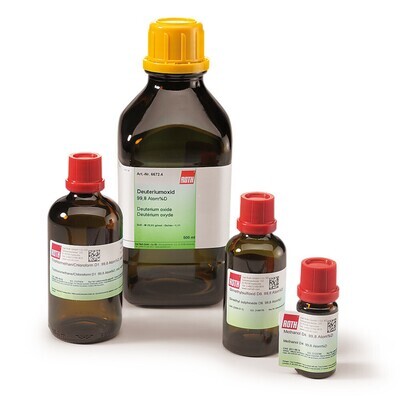Verzending 24–48 u • Levering in de hele EU • Veilige chemieverpakking
Dextrin, 250 g
SKU 3488.1
€ 56,28
In stock
1
Save this product for later
Dextrin, 250 g
Product Details
CAS number: 103476-89-7
Chemical formulas: C20H38N6O4 · 0,5 H2SO4
HS code: 35051010
Brand: Carl Roth
Dextrin, for microbiology, CAS No. [9004-53-9], EG-Nr. 232-675-4, Empirical formula (C6H10O5)n · x H2O
Sugar (Carbohydrates)
Carbohydrates or Saccharides make up 50 % of the dry biomass of the earth and are therefore the most frequent class of biomolecules. Besides at least two hydroxy groups, they also have an aldehyde or a ketone group and can be subdivided according to the number of monomeric components in mono-, di-, oligo and polysaccharides.
Whereas mono-, di- and oligosaccharides are soluble in water, taste sweet and are therefore called as sugar, polysaccharides are hardly, or not at all, soluble in water and have a neutral taste.
Carbohydrates, together with fats and proteins make up a large percentage of nutrition. In addition to their central role as an energy source, they are also an important structural component especially in plants (e.g. Cellulose). Ribose, a monosaccaride with five carbons (C5H10O5) is an essential element of coenzymes (such as ATP, FAD and NAD) and a structural component of RNA. Desoxyribose (a ribose derivative) is a structural component of DNA.
Oligo- and polysaccharides
Oligosaccharides consist of three to nine monosaccharide units.
Polysaccharides are macromolecular substances that consist of ≥10 monosaccharide units. A distinction is made between homoglycans, which are made up of only one type of monosaccharides (e.g. starch) and heteroglycans, which consist of at least two different monomeric components (e.g. xanthan).
| Appearance | light yellow powder |
You May Also Like

N-Boc-2-methylamino-ethylamine, 95.0%, 25g
N-Boc-2-methylamino-ethylamine, 95.0%, 25g
SKU F075570-25G
€ 47,30
Display prices in:EUR









![3-BROMO-1H-PYRROLO[2,3-B]PYRIDINE-5-CARBOXYLIC ACID, 95.0%, 100mg 3-BROMO-1H-PYRROLO[2,3-B]PYRIDINE-5-CARBOXYLIC ACID, 95.0%, 100mg](https://d2j6dbq0eux0bg.cloudfront.net/images/88473019/4861293156.png)


